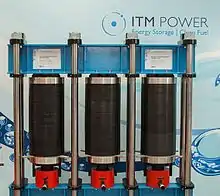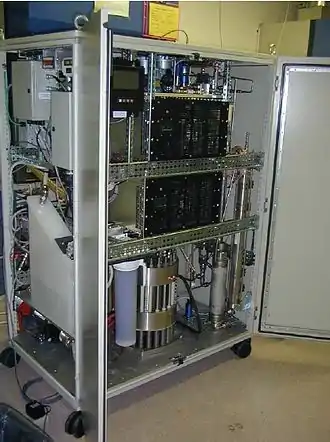High-pressure electrolysis
High-pressure electrolysis (HPE) is the electrolysis of water by decomposition of water (H2O) into oxygen (O2) and hydrogen gas (H2) due to the passing of an electric current through the water.[1] The difference with a standard proton exchange membrane electrolyzer is the compressed hydrogen output around 12–20 megapascals (120–200 bar)[2] at 70 °C.[3] By pressurising the hydrogen in the electrolyser the need for an external hydrogen compressor is eliminated, the average energy consumption for internal differential pressure compression is around 3%.[4]



Approaches
As the required compression power for water is less than that for hydrogen-gas the water is pumped up to a high-pressure,[5] in the other approach differential pressure is used.[6] There is also an importance for the electrolyser stacks to be able to accept a fluctuating electrical input, such as that found with renewable energy.[7] This then enables the ability to help with grid balancing and energy storage.
Ultrahigh-pressure electrolysis
Ultrahigh-pressure electrolysis is high-pressure electrolysis operating at 340–690 bars (5,000–10,000 psi).[8] At ultra-high pressures the water solubility and cross-permeation across the membrane of H2 and O2 is affecting hydrogen purity, modified PEMs are used to reduce cross-permeation in combination with catalytic H2/O2 recombiners to maintain H2 levels in O2 and O2 levels in H2 at values compatible with hydrogen safety requirements.[9][10]
Research
The US DOE believes that high-pressure electrolysis, supported by ongoing research and development, will contribute to the enabling and acceptance of technologies where hydrogen is the energy carrier between renewable energy resources and clean energy consumers.[11]
High-pressure electrolysis is being investigated by the DOE for efficient production of hydrogen from water. The target total in 2005 is $4.75 per gge H2 at an efficiency of 64%.[10] The total goal for the DOE in 2010 is $2.85 per gge H2 at an efficiency of 75%.[11] As of 2005 the DOE provided a total of $1,563,882 worth of funding for research.[10]
Mitsubishi is pursuing such technology with its High-pressure hydrogen energy generator (HHEG) project.[12]
The Forschungszentrum Jülich, in Jülich Germany is currently researching the cost reduction of components used in high-pressure PEM electrolysis in the EKOLYSER [13] project. The primary goal of this research is to improve performance and gas purity, reduce cost and volume of expensive materials and reach the alternative energy targets set forth by the German government for 2050 in the Energy Concept published in 2010.[14][15]
References
- "High pressure electrolysis". Archived from the original on 2009-05-02. Retrieved 2009-01-06.
- 2001-High pressure electrolysis – The key technology for efficient H.2
- "Investigations of hydrogen compressor based on proton exchange membrane" (PDF). Archived from the original (PDF) on 2011-07-25. Retrieved 2009-04-13.
- 2003-PHOEBUS-Pag.9 Archived 2009-03-27 at the Wayback Machine
- Prediction of production power for high-pressure hydrogen by high-pressure water electrolysis
- Differential pressure
- "Archived copy". Archived from the original on 2013-05-12. Retrieved 2013-05-20.CS1 maint: archived copy as title (link)
- XI.13 High-Efficiency, Ultra-High Pressure Electrolysis with Direct Linkage to Photovoltaic Arrays (Phase II Project) (Available here Accessed 2008-08-9.)
- Hydrogen safety aspects related to high pressure PEM water electrolysis
- 2005 DOE H2 Program Review Alkaline, High Pressure Electrolysis. (Available here Accessed 2008-08-9.)
- Alkaline, High Pressure Electrolysis (Available here Accessed 2008-08-9.)
- Mitsubishi Monitor August and September 2004 (available here Accessed 2008-08-9.)
- "Forschungszentrum Jülich EKOLYSER Project". Retrieved 27 May 2013.
- "Das Energiekonzept der Bundesregierung 2010 und die Energiewende 2011" (PDF). Archived from the original (PDF) on 2013-02-26.
- Carmo, M; Fritz D; Mergel J; Stolten D (2013). "A comprehensive review on PEM water electrolysis". Journal of Hydrogen Energy. 38 (12): 4901. doi:10.1016/j.ijhydene.2013.01.151.